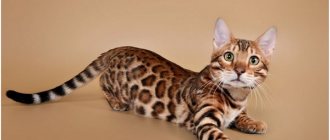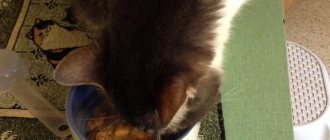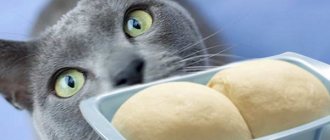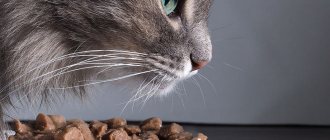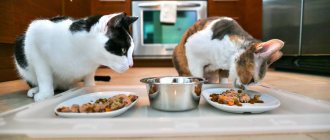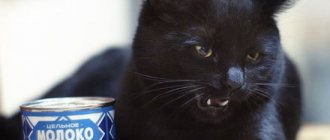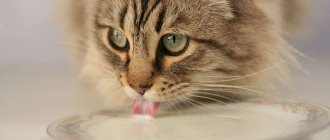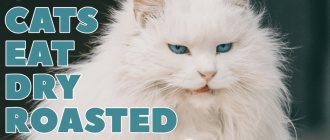Cats are carnivores, which is why they need to consume at least a small amount of meat every day. The ancestors of domestic cats hunted artiodactyls, which means that cats can eat beef and it will not cause harm.
It’s hard to imagine how a small cat attacks a cow and kills it, tearing it into pieces. Domestic cats are unlikely to dare to take on such large prey. Some owners give their pets live birds and rats to diversify their pet's diet. This is not worth doing.
In nature, wild cats catch prey, tear it apart with sharp fangs and claws and eat it along with cartilage, ligaments, blood vessels, tendons and even fur. This leads to the conclusion that you can give your cat raw beef, right? Each of the elements contained in beef is necessary for the cat, as it saturates its body with the necessary chemical elements (vitamins, amino acids, etc.) and normalizes the functioning of the digestive system. Thus, you can give beef to your cat, but should you limit it to only one type of meat product?
What kind of meat can you give to a cat?
Cats get proteins and amino acids from meat. They need proteins more than other domestic animals: if they are deficient, liver enzymes break down their own proteins. Meat becomes the main source of taurine. It is not synthesized in the body of cats; if there is a deficiency, vision decreases and the functioning of internal organs is disrupted.
The benefits of the product increase if it is processed correctly:
- The cats are fed fresh fillet of meat. Skin, bones, and fatty layers are removed. The exception is chicken necks and cartilage; they are ground in a meat grinder and periodically given to the pet.
- The pieces are cut into slices 1 cm in size: they give the necessary load to the teeth, gums and are absorbed normally.
- Minced meat is prepared from lean varieties, but is not given regularly.
- Before serving, bring to room temperature or 2 degrees higher: hot burns the mucous membranes, frozen is harmful to the stomach.
- During heat treatment, no fat, salt, or spices are added. It is useful to season with vegetable oil.
- Offal is included as an additional source of vitamins and minerals and is fed twice a week. The liver and heart are more useful, the lungs, kidneys, and stomachs are allowed if the animal loves them.
The types of meat alternate, they differ in the composition of useful components.
The table indicates the varieties that can be given to your pet:
| View | Benefits for cats |
| Chicken breast | Includes unsaturated fatty acids and exceeds other varieties in terms of calcium volume. |
| Dark meat chicken | 100 g contains 1700 mcg of taurine, which is 3 times more than beef. |
| Turkey breast | Does not cause allergies, contains only 104 kcal and 1.6 g of fat per 100 g. |
| Dark turkey | The share of taurine in 100 g is 3000 mcg. |
| Rabbit meat | Contains 21.7% easy-to-digest proteins. |
| horsemeat | It consists of 21% protein and 4.1% fat. It is distinguished by an increased amount of iron, potassium, copper, manganese. |
| Beef and chicken liver | The proportion of iron, vitamin A, E, group B is higher than in muscle fibers. |
| Chicken and beef heart | The chemical composition is not inferior to meat, but it is superior in the content of vitamins A, PP, B1. |
| Chicken necks | Prevents the formation of tartar and becomes a source of calcium. |
| Soft cartilage | Contain collagen, necessary for the renewal of connective tissues of joints. |
| Beef tenderloin | Normal ratio of proteins and fats: 18.6/16%, rich in minerals, superior to other varieties in the amount of zinc. Vitamins B6, B12 and iron support hemoglobin levels. |
| Veal | Contains 1.2% fat, its mineral composition and amount of proteins is not inferior to beef. |
The diet cannot be composed of only meat “dishes”. They don’t have fiber, they don’t have enough vitamins and calcium to meet the daily requirement. The deficiency is compensated by fermented milk products and vegetables.
Taurine
Taurine is an absolutely essential amino acid for cats that cannot be synthesized by them on their own. However, with its prolonged deficiency, the cat may lose vision, there may be disturbances in the functioning of the cardiovascular system, a weakening of the reproductive functions of the body, and a general deterioration in well-being.
Table 8.
Taurine Content of Some Foods
Of course, taurine can be purchased as a supplement and is often included in cat vitamins. But with a balanced natural diet, a cat can easily get all the taurine it needs from meat. The main thing is to know which types of meat contain more of it.
Most taurine is found in seafood, whole chickens, dark chicken and turkey meat.
If you feed your cat boiled meat, you need to know that taurine is washed out of the meat during cooking. Therefore, it is better to stew the meat in its own juice or boil it in a very small amount of water, and then give this broth to the cat or cook vegetables/cereals in it for the cat.
So, what is the best meat for a cat? The answer is variety! Use a variety of meats to best meet your cat's nutritional needs. Don't forget to add vegetables, some cereals and vitamin-mineral complexes to the meat.
Remember: proper nutrition is the key to good health and long life for your pets!
It is widely believed that many foods can be given to a cat in their raw, original form, and nothing will happen to the animal. Is it so? Can cats eat raw meat and other raw foods? Is this kind of feeding beneficial for a cat? Let's try together to consider this issue in more detail and understand all the nuances.
Many, even experienced cat owners, are not really well versed in the issue of proper feeding of their mustachioed pets. It seems that there is nothing difficult in this - feed with ordinary food that people eat themselves, and that’s the end of it. However, everything is not so simple, and the animal’s body treats many products in a completely different way than it seems to people.
As many adherents of raw feeding quite rightly believe, cats in nature do not prepare their own food, but eat their prey raw. This is precisely why people argue that cats should be fed raw foods - they say that it is healthier and more natural for the cat’s body. However, here the first argument against it arises: our pets are no longer the wild cats that got their food in nature, which means that in the course of selection and long coexistence with humans, domestic cats have significantly changed their lifestyle, as well as their digestion. That is why there is no clear answer to the question of whether cats can eat raw meat - it all depends on many factors. Let's discuss the different types of foods and their effects in raw form on the body of domestic cats.
Can cats eat raw meat? No matter how much we would like to idealize our gentle purrs, they are real predators, which means that their main diet should be meat in its various types. And this is where the burning question arises: can cats eat raw meat, or should it be processed before feeding?
In fact, cats can, and even need, raw meat, because their stomach and digestive tract are perfectly adapted to obtain energy from high-protein foods. Small kittens must be fed raw meat without fail, because their proper development and formation depends on this, but with caution, and if you are confident in the quality of the meat.
It is also worth considering that cats are only allowed to eat beef, as pork is too fatty for their digestion and can cause stomach upset. In addition, pork consumption often causes obesity, which is very harmful to the pet’s internal organs. Beef, in addition to all the necessary nutrients, is an excellent source of taurine, which is vital for your animal during the active growth stage and in later life. However, it is worth remembering that meat contains a lot of phosphorus, but practically no calcium. Its deficiency must be replenished, otherwise your cat runs the risk of developing fragile bones.
If we summarize all of the above, then we can confidently answer the question of whether cats can be given raw meat in the affirmative, but the meat should be frozen before feeding!
What meat should you not feed your cat?
The following products are prohibited:
- Fresh steam . Unprocessed meat is a potential source of harmful bacteria, helminth larvae and eggs.
- Salty . Salt disrupts the balance of minerals and retains fluid.
- Fried . Excess oil upsets metabolism.
- Canned . To increase shelf life, components harmful to cats are included: salt, seasonings, spices.
- Smoked . Wood smoke contains volatile carcinogens. When smoking for industrial purposes, meat is doused with an artificial liquid, which corrodes the gastric mucosa and causes an allergic reaction.
- Dried . The product is kept in a marinade with additives harmful to animals: salt, vinegar, spices, garlic.
- Meat waste . Bones, paws, and heads injure the digestive organs; cats do not digest chicken and turkey skin. The trimmings are taken from the surface of the piece, and therefore contain pathogenic microbes.
- Pieces larger than 2 cm . Large chunks are difficult to chew, making nutrients less absorbable.
- Meat puree . A cat's teeth need stress; if you constantly feed them soft food, they are destroyed. The puree is suitable for kittens or adult animals with digestive tract problems.
The table lists the varieties that should not be given to your pet:
| View | Harm to the cat |
| Pork | A protein to fat ratio of 14:33 is not good for a cat. Contains histamines. Possible source of parasites. |
| Goose | The muscle tissue of birds older than six months becomes tough and difficult to digest. Fat content reaches 38%, calorie content 369 kcal. |
| Mutton | Difficult to digest, high fat content. |
| Duck | In terms of calories and fat, it is comparable to goose. |
| Fresh liver | Poorly absorbed, causes diarrhea. |
| Raw chicken | There is a risk of salmonellosis infection. |
| Pork by-products | They have the same negative qualities as meat. |
| Raw lung | Not digestible, poor composition of nutrients. |
| Store-bought minced meat | Contains fat, skin. |
| Necks of domestic chickens | The vertebrae are too hard for cats. |
A one-time inclusion of fatty meat in your diet will not harm. With constant feeding, the animal develops problems. First, weight increases, and against the background of obesity, cardiovascular diseases and diabetes develop.
Rules for use and inclusion in the diet
You can start feeding your kitten meat at about 2-2.5 months. From a large piece of beef, scrape off a small amount and freeze separately. The first time you need to give your pet 2-3 g of the resulting minced meat and watch his reaction.
After eating, it is also necessary to observe him, because... Unusual food may make him feel bad.
Beef should be introduced into a kitten's diet in small portions.
Beef is better than other meats for starting complementary feeding. It is tougher than pork and chicken, the animal will quickly develop chewing skills and the gums will become stronger.
Daily norm
To keep your cat healthy and active, you need to calculate your daily meat intake. The easiest way is to take a serving that is 5% of your pet’s body weight. However, you can calculate calorie content using a special formula:
- K*(30*m + 70), where K is the multiplier coefficient, and m is the weight of the animal.
The values of the K indicator are given in the table:
| Physiological characteristics of a cat | K coefficient value |
| lactation | 2-4 |
| pregnancy | 1,6-2 |
| active adult animal | 1,6 |
| adult passive individual | 1,4 |
| kitten or light weight | 1,2-1,4 |
| sterilized cat | 1,2 |
| elderly cat | 1,1 |
| tendency to be overweight | 1 |
| obesity | 0,8 |
Restrictions
Due to the fact that beef is not a fatty meat, you can feed it to your cat every day. However, the following rules must be observed:
- for kittens no more than 30 g at a time;
- adults 100-120 g per dose.
Do not salt beef or add seasonings.
Why raw meat can be dangerous
The harm of the fresh product is associated with possible infection with helminths and harmful microbes.
These include:
- Campylobacter lives in the intestines of animals and birds and causes the acute intestinal disorder campylobacteriosis.
- The “false rabies” virus is contained in pork; when infected, convulsions, paralysis, and itching begin.
- Escherichia coli , pathogenic strains provoke acute poisoning.
- Salmonella is more often found in chicken. Bacterial toxins cause vomiting, diarrhea, and dehydration.
- Brucella enters the body with the milk and meat of sick animals. The bacterium affects nerve cells, blood vessels, and genitourinary organs. Brucellosis is not completely cured.
- Trichinella is found in pork. After entering the intestines, they penetrate the walls, spread through the bloodstream, and settle in the muscles. Trichinosis is fatal if there are more than 5 larvae per 1 kg of weight in the body.
It is better not to buy products in dubious places where the quality of the goods is not controlled.
The nuances of purchasing pork
This product has earned a bad reputation because owners make mistakes when purchasing it. But they can be avoided quite easily:
- You should take a responsible approach to purchasing any meat products, and pork is no exception. It is recommended to avoid spontaneous markets where sanitary standards, storage and sales conditions are not observed. You shouldn’t think that if the van of a dubious car says “homemade, fresh, fresh meat”, then that’s what it is. Often, a product from “their own farm” turns out to be written off and “refined” as a store product. In addition, it is rare that small farms follow all the rules for raising livestock, carry out regular vaccinations, and store meat in appropriate conditions. When purchasing pork from a private seller, you can play it safe and ask for a certificate issued by the veterinary control.
- Sellers' tricks. And what “miraculous” tricks do some unscrupulous traders have to give a stale product an appetizing appearance! For example, aging in a salt solution and subsequent coloring makes the product not only more attractive, but also significantly larger and heavier. Such meat will definitely attract the attention of buyers. Also, expired food gets a “new life” after marinating and packaging in separate, sealed bags. Marinades perfectly eliminate the putrid “smell” of the product. And hermetically sealed packaging does not allow the “aroma” of rot to be captured. It also compresses the product, making it look denser and more attractive. Meat products in a vacuum are a fertile breeding ground for all kinds of pathogenic microorganisms.
- When buying pork, regardless of whether it is intended to feed people or a domestic cat, you should remember that the product should only be stored in the freezer or on the shelf of a refrigerated counter. In addition, it must be protected from dust and the hands of potential buyers. You should carefully look at the shelf life of the product and the seller’s compliance with personal hygiene measures. If the meat is weathered and flies are crawling on it, then it is better to avoid such goods without endangering yourself and your furry pet.
How to keep meat safe
Bacteria, parasites, and viruses die at high and low temperatures; to reduce the risk of infection, the following methods are used:
- Freezing . In home refrigerators, at minus 18℃, parasites die in 4 days. This does not apply to trichinella and salmonella; frost does not affect them.
- Cooking . In boiling water, viruses and bacteria die within 1 – 20 minutes; it will take 3 hours to destroy Trichinella.
When scalded with boiling water, bacteria are destroyed from the surface; this method will not protect against helminthiasis. Meat is not kept next to other food; a separate knife and cutting board are allocated for it.
Raw or cooked
Fresh meat is better digestible and retains nutritional components. Boiled is safer, cats often eat it more willingly, but the taurine and vitamins are partially washed out.
Both types are allowed if prepared correctly:
- Do not serve raw without first freezing.
- When cooking, add a minimum of water or simmer in its own juice.
- Freeze the liver, chop it and scald it with boiling water.
- Do not combine fresh and cooked food in one feeding; different enzymes are required for absorption.
Meat is the main food of a cat's diet, but not all types are suitable for feeding a cat; it becomes useful only after processing.
Mixed nutrition
There are three types of diet for domestic cats:
- natural nutrition from ordinary products familiar to humans;
- feeding with ready-made industrial feed created for animals;
- mixed diet, which involves feeding cats natural products in combination with ready-made food.
Natural food and raw meat
When feeding natural food, the issue with raw meat is resolved on its own. This product is included in the pet menu. It can be served in processed form. To get a more nutritious meal, veterinarians recommend combining meat pieces with other healthy foods.
Dry, wet food and raw meat
Is it necessary to feed a cat raw meat if it regularly eats ready-made industrial food?

